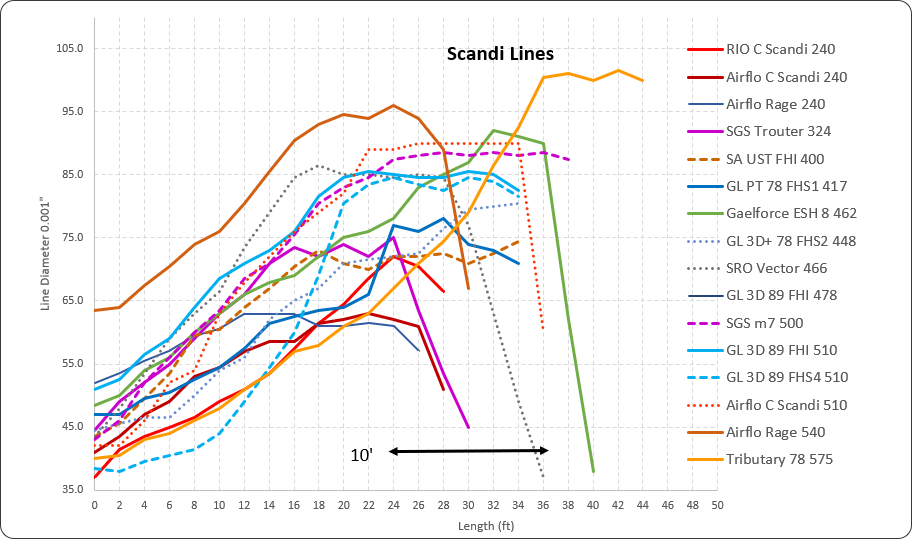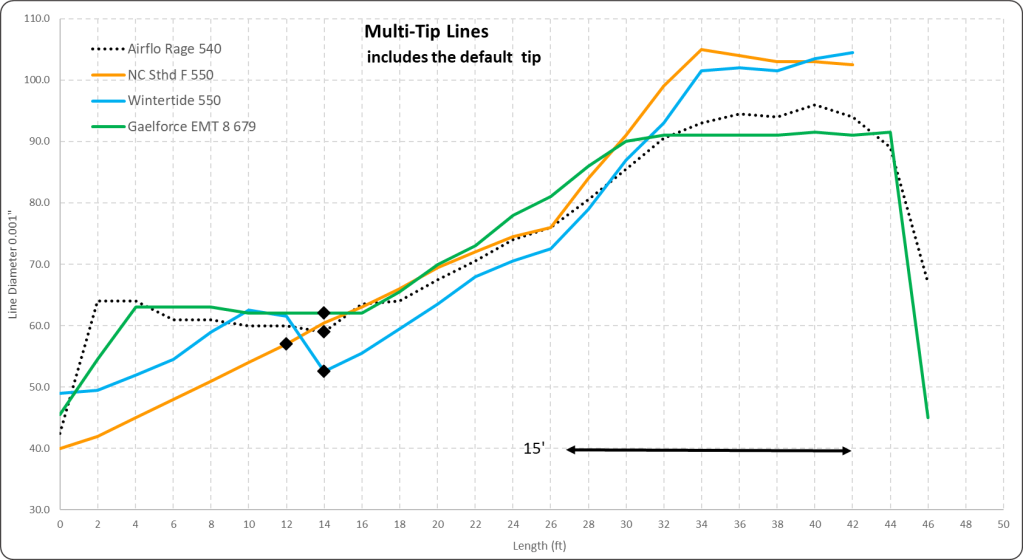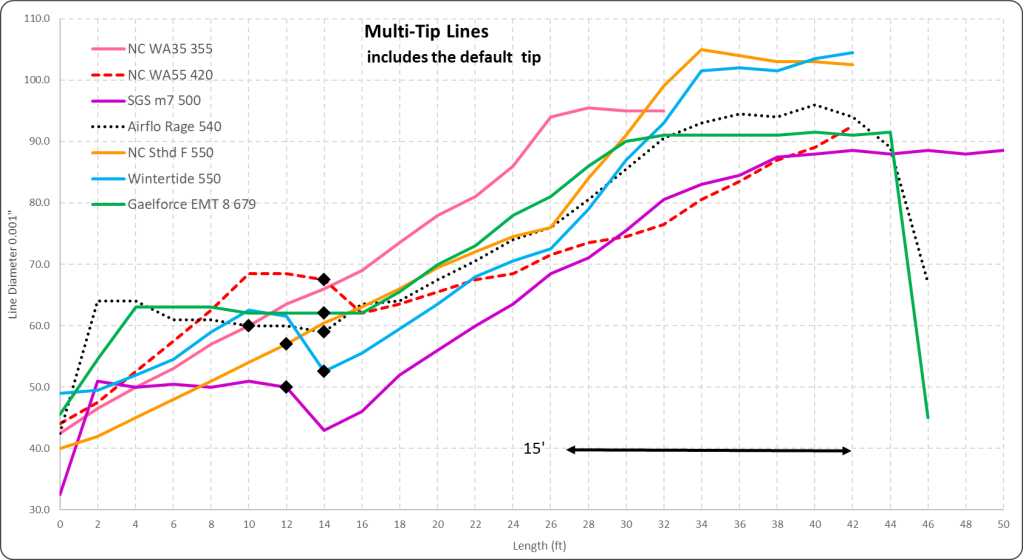Bahamas 2024, Day -1
Our sixth Bonefishing Trip to the Bahamas, starts tomorrow (tonight we head to Toronto) with our flight to the Bahamas. Note much has change from previous posts, but I note some changes and observations.
- Like many countries, including Canada, the government of Bahamas is expecting you to pre-check-in with their online “app” (Bahamas Exempt). Almost a VISA, but no fee. The App is fine, but expect 30 minutes to create an account and complete the authorization to enter.
- All other forms, such as the fishing license (which was a debacle, when first introduce) is fine.
- Remember Bahamas uses and prefers cash.
- Our spring – in eastern Ontario – is at least 2 weeks earlier this year.
- Weather forecasting for the Bahamas is never great, but the 10 day forecast looks to be what we normally expect.
- We picked this week for lowest tides.
- I will be testing out a new paid “app” called Navitide, whose closest station is on Long Island. I expect a 60+ minute lag.
- This “app” is what we used for help confirm the dates, and it appears to be a good investment.
- This “app” is what we used for help confirm the dates, and it appears to be a good investment.
- Of late – assume to be a function of saving cost, shortage of planes and pilots, I have found my flights frequently reschedule, and this trip is no exception. We had originally expected to arrive in the Exumas before 4pm, which would allow us to get groceries, but the schedule was changed and added 2 hours, giving us a long pause in Nassau and we will not have enough time to get groceries. 😦
- The area around the cottage is building out, so we fear some of the past peace and quiet may be lost. I really enjoy doing nothing on the patio and then seeing the dark sky in solitude. So we will be exploring alternatives.
- We are taking a cribbage board.
- We are taking a cribbage board.
- No change in rods, reels, lines or flies. (One exception: A few right hand cast Alphexo flies in white)
- I added a very small waterproof green LED light that I can wrap a pole, if we leave the kayaks on a bar in the evening.
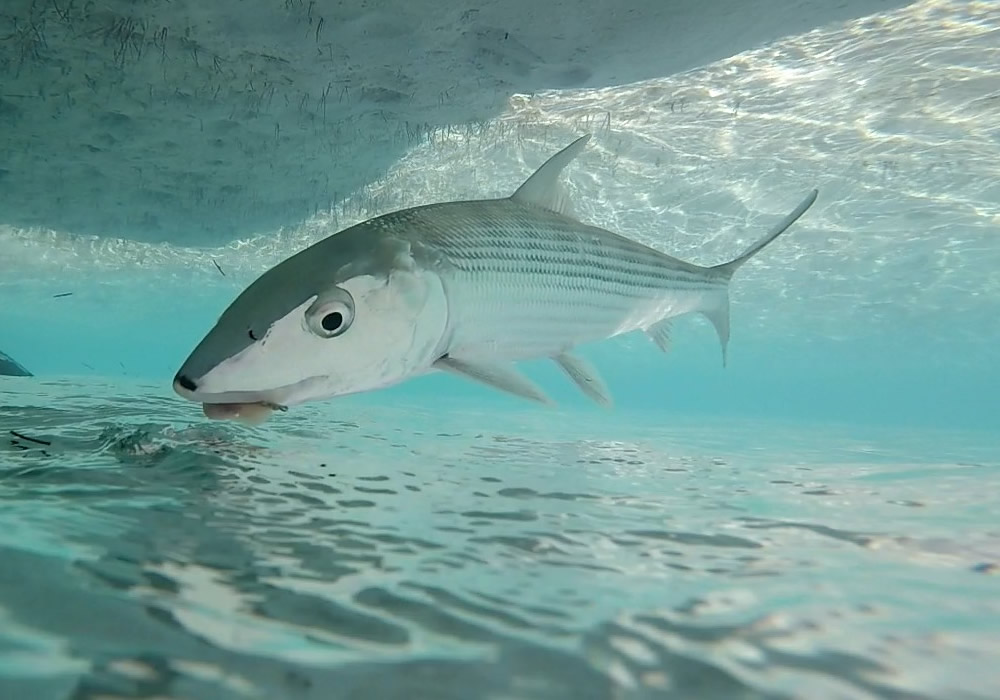
.
🙂
James Green Trout Switch Handle – build start
.
I really like my 10′ 5wt James Green rod, with the vanity exception I wish I put my colour into it, rather than the black and brown. So, here is my second rod.
As I wanted a stablized reel seat – dyed blue-purple from Mike at Snake Brand – I have to assemble the handle on a 1/2″ stint (as the diameter of the blank is to big into the seat).
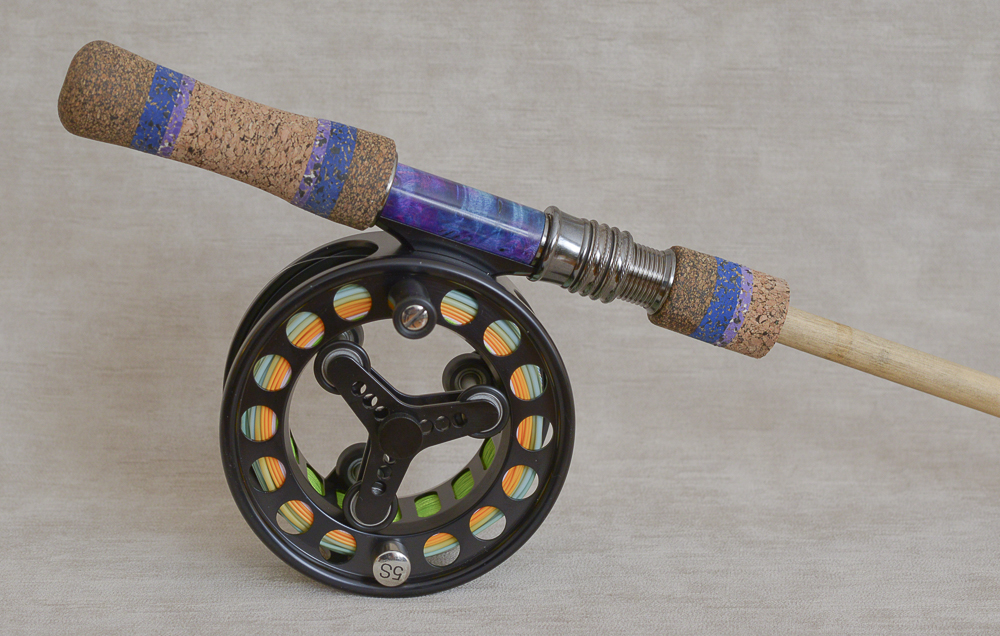
.
.
The handle was shape short (no surprise, given my previous blogs), but I can get a full comfortable grip aroud the butt.

.
.
and I can get the complete hand on the lower grip, and with a tight grip:
- My fingers are not digging into my palm
- My thumb is on the reel seat
- and I am not interferring with the reel
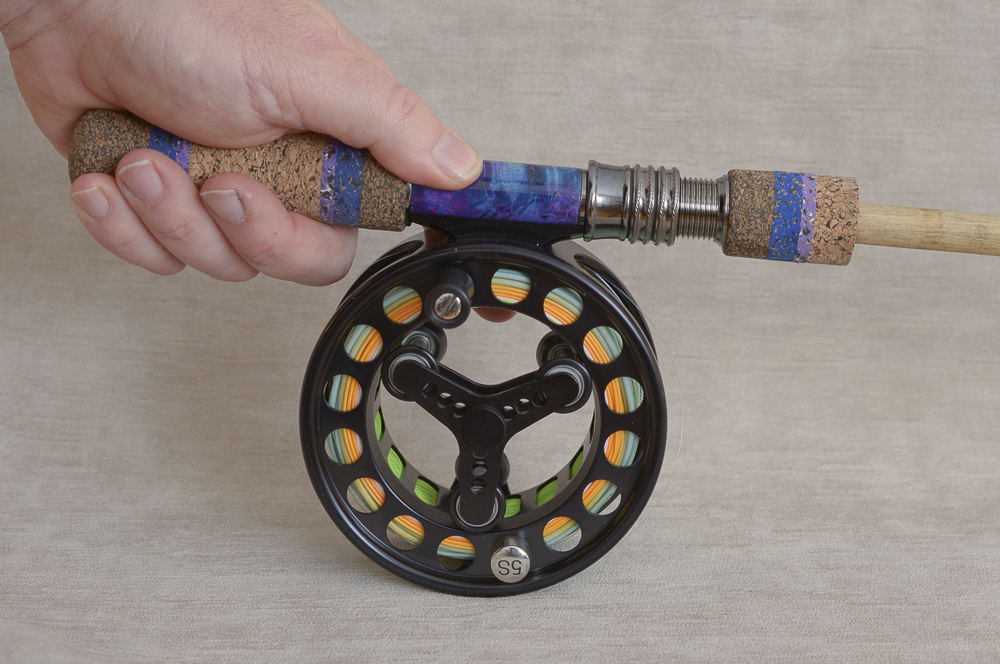
.
.
And how does this compare with the previous 2 builds – long rods.
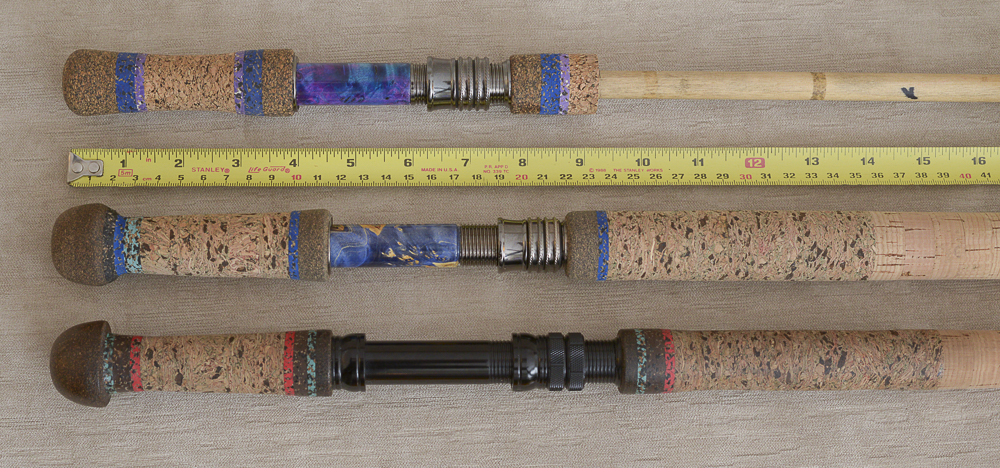
.
.
So I continue with short lower grips, where the lower grip is between 4 to 5″.
.
For a later post, but I have epoxy in the stint (joing the rod and lower handle (good flex remains), put on the cork and turned the upper on my lathe.
.
🙂
.
Spey Lower Handle
At my start of learning to spey, I was in instructed to change my lower grip to hold the butt (and not the lower handle) to help me rotate the rod. In keeping with concept, I see lower handles that are longer than needed, and recently came across a discussion from Ian Gordon “to hold the handle”; which requires a rod’s lower handle to 5 to 7″ long, depending on the reel seat and transition (flare) and the butt.
But if I look at Klaus Frimer’s training video’s and zoom in, I can see he is holding the lower 2″ and allowing the rod to rotate in his group, as I was taught many season ago.
We can see some different spey rod manufacturer’s try to accommodate both with “ONE” a long lower handle, and “TWO” a feature at the bottom. This bottom feature may be pronounced and a few are round.
Shape Survey
If we do a survey today, who supports the lower round socket (by default) include Bruce & Walker, Loomis Asquith (small), Meiser, Scott Swing (small) and Winston Spey Air (small).
Where the majority replicate a small (mostly) flat butt cap: Burkheimer 7134, Gaelforce Destination, Guideline NT11, Loop 7x, NAM Ren, Sage X, Scott Swing, and Thomas DNA.
Thus, I conclude my preference for a sizable round butt, it is not reflect in your standard spey rod.
It should be recognized, some manufacturer’s such Meiser and RJC will built to suit.
and length
And unless we got to switch rods, all rods had a long lower handle.
If we recognizing my preference (and style) over 10 years of pivoting the base, a rounded butt is good, but a a long lower handle serves no benefit and has a cost of requiring a heavier reel to balance in the swing.
.
My design and build
The advantage of building one own rod, you can create a feature to one’s taste.
For single hand rods, for a relax grip, I like a simple large cylinder. My hand can shift and to grip the rod, my muscle contraction is not extreme and my fingers are not pushing into the palm. Yes, a fine and small grip looks sleek, but it is not the most comfortable.
When I built and tested different handles with the Quantum Rod,
- I kept a ball socket butt, with a small taper to the butt.
- No other flairs, so the transition from reel seat to the lower and upper handles
.
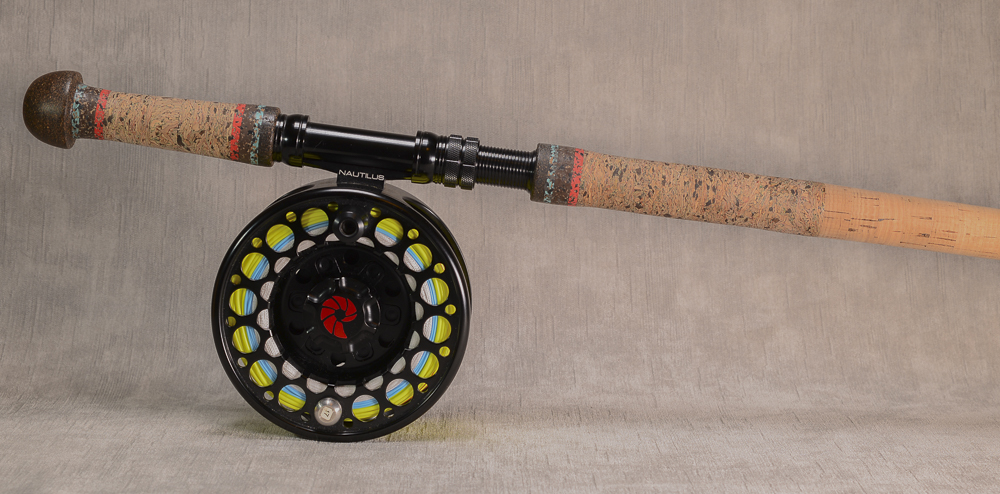
.
And with my latest build, a Meiser 1507S
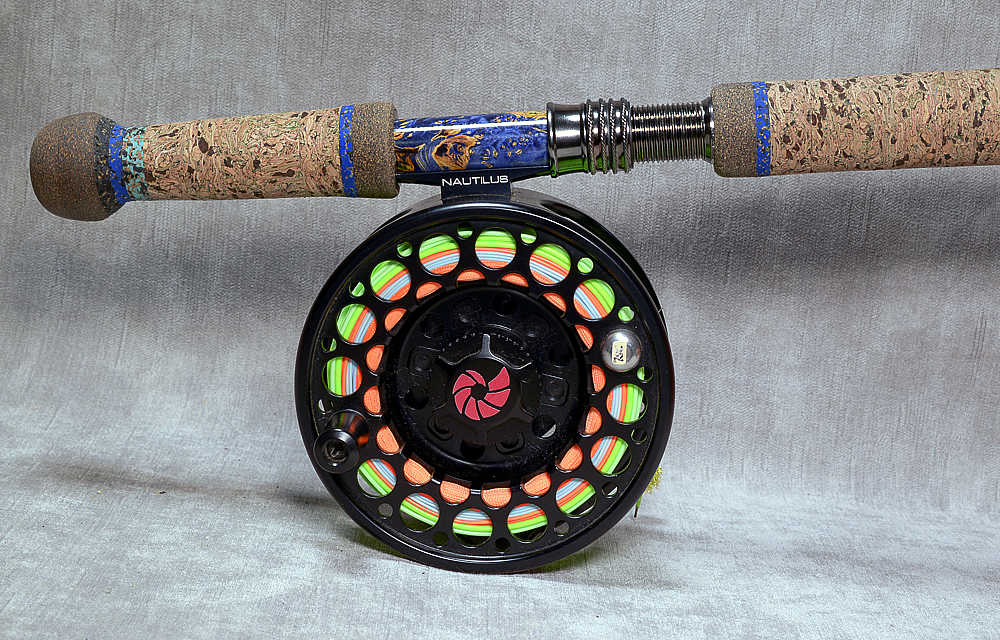
.
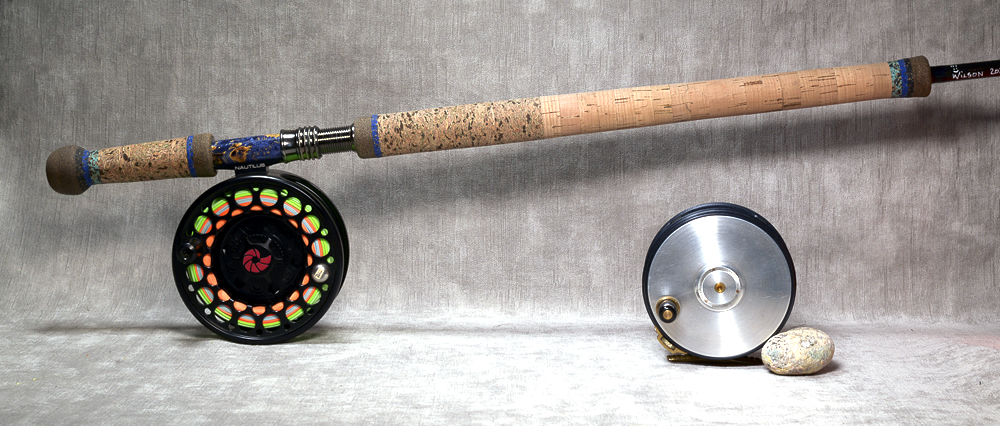
.
I kept the same principles, but the transition from the lower handle to the ball socket is not as extreme. I did want a “slightly” more rounded transition, but the black rubberized cork was tearing out, irrespective of the tools I was using (carbide, HSS steel in skew or gouge) (the remainder of the black cork again, where I need to turn it to shape).
.
Even when wet, I find my hand registers the change in cork, size and-or type, so on the upper handle, the transition to burl cork or rubber cork supports a subtle feedback loop.
.
So yes, I am “holding” the socket.
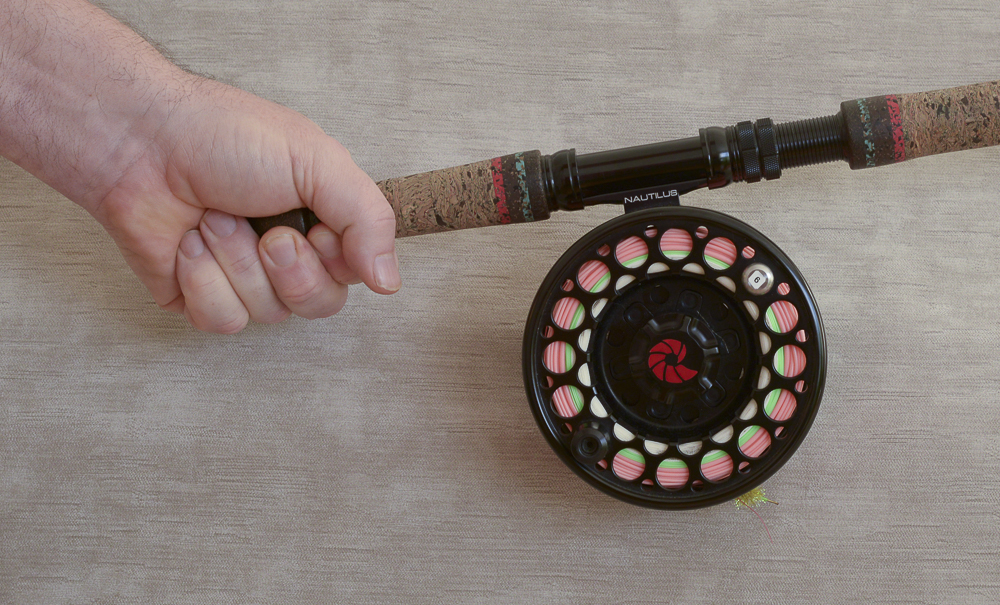
.
and there is a lot of room to move my hand.
.
And I am not holding the rear handle, but I can
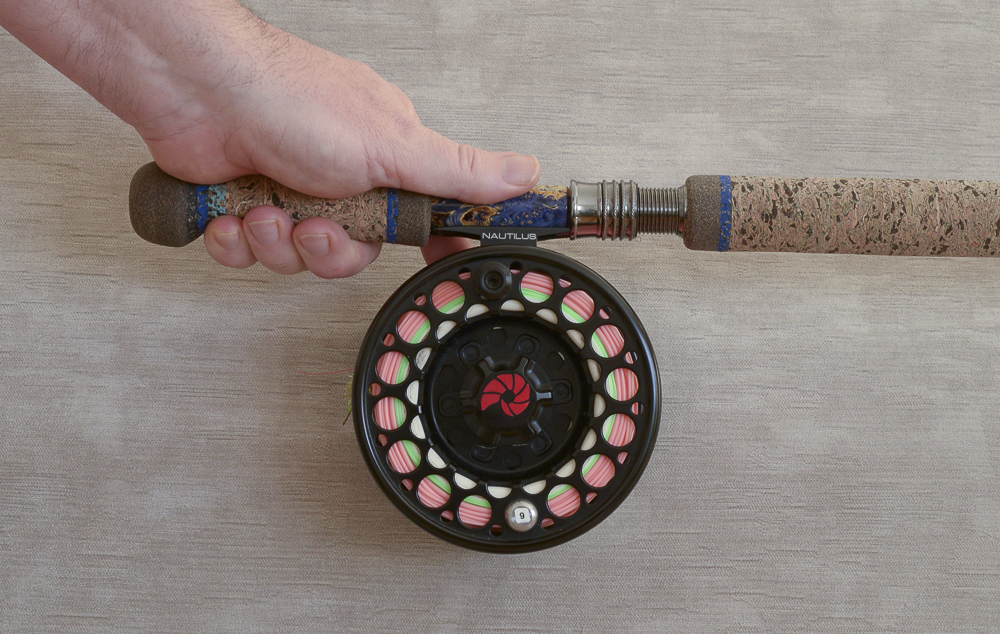
.
and if you notice, I have shorten the lower grip, such that my thumb rides onto the reel seat and I can use my index finger to touch-feel the reel.
With the slightly longer lower handle on the Quantum
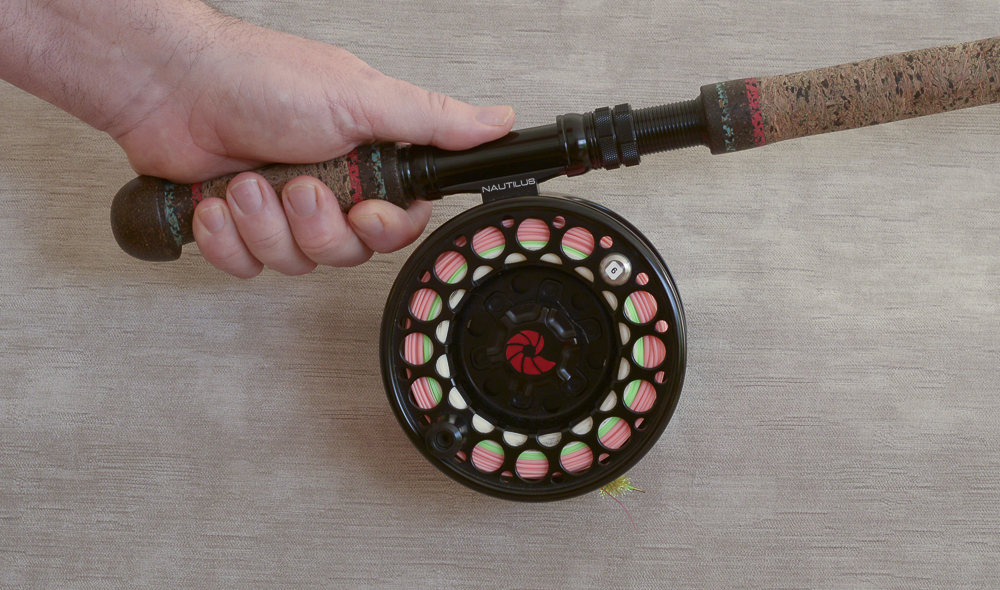
.
Compare to a standard build, a Walker 9wt
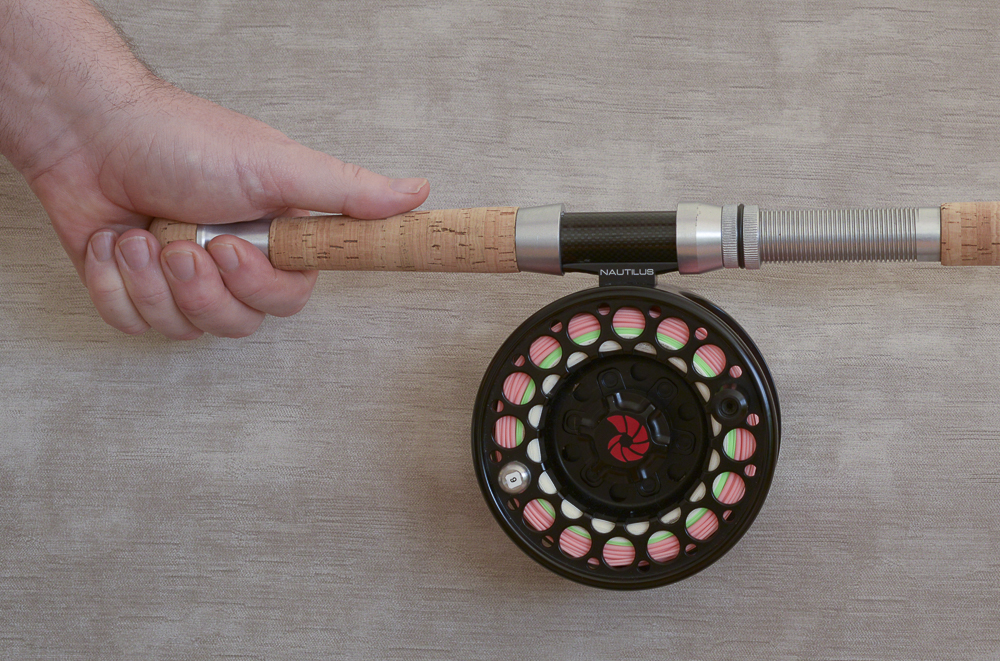
.
And given my style, there is no gain-advantage to longer lower handle, but there is a cost that I need a heavier reel to help the balance in the swing.
.
Comparison
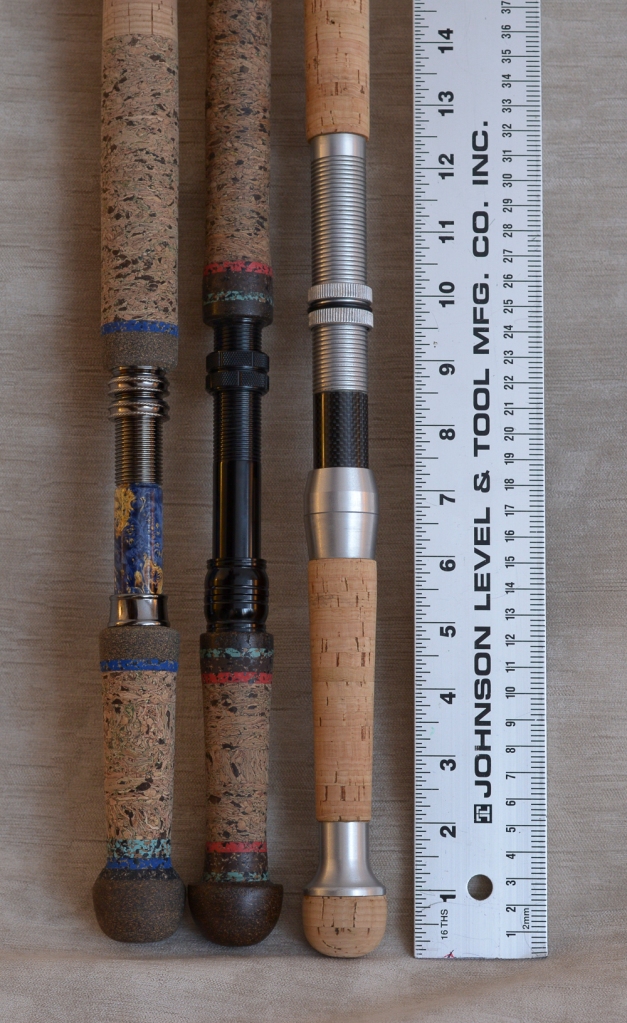
.
With the Walker 9wt (right)with the reel hood at just over 6.5″, where as the Quantum (middle) close to 5 1/2″ and the Meiser 1507S (on the left), with an inset reel seat at 4 3/4″.
And though the Meiser 1507S is fine as shown above, it is tight.

.
So what is the right feature for me?
- Ball Socket butt
- 5″ from butt to the emergence the reel seat, out of the reel seat (the Quantum).
.
This all nice to know, but I do not need another rod (other than maybe a 5pc Meiser Trout Rod), so unless I am building my own Spey Bamboo Rod, I am not likely to use this knowledge. Never-the-less, it is worth to document where I finished off at.
.
NAM Product Page
I usually do not reference another page, as links break with time, but I thought this image was worth capturing and sharing. From NAM USA’s homepage, you can clearly see the caster is holding the butt, and with NAM who already has a small lower handle you can see substantial clearance between reel and hand.

.
Handles look good, but the butt is a large swell with a flat bottom.
.
🙂
.
Long (mid) Spey Line Survey
This journey started with a desire to understand what made the discontinued CND GPS a beloved Unicorn for long rods – Meiser 15’6″ 5wt or 16’7″ 7wt Quantum. After many practice sessions, many notes and measuring dozens of line, my work is coming to an end – whether it is looking at manufacturers and line types – Scandi, Multi-Tip and Long (Mid) Belly Spey Lines. Hopefully, I can use this information in the future to make a wiser selection of a line for a rod or even making my own custom line for my long rods.
Caution: A review of a taper measurement does not address differences in plastics and core, so it is an indicator.
Caution: In additional, a fly rod throws weight and not diameter, so when one looks at a change in diameter changes, remember the change in area-mass is accelerated by the “power of two” – r2.
So what does my long line spey database (graph) now include:
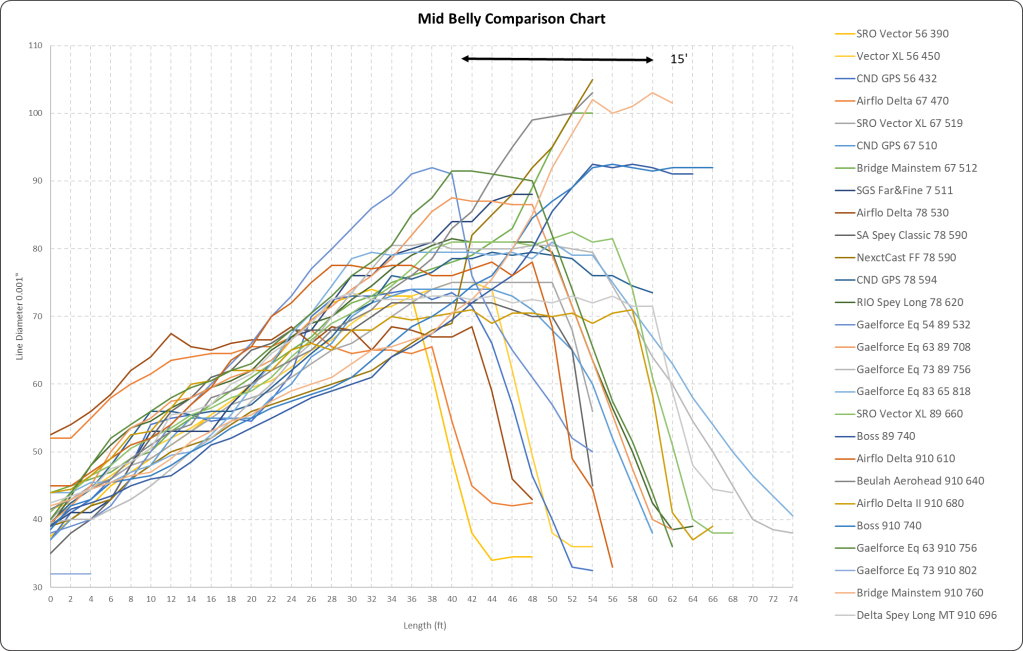
.
Some additional notes, all measurements are made by my Mitutoyo Vernier Caliper, and since I measuring against a soft body of a shape that is not perfectly round, there will be some measurement variances.
I found Excel not able to hold custom formatting once we move more than 10 datalines – especially as you change the order of the data. So rather than trying to re-create the same look of each data line, I quickly set a set of colour and lines for each individual message.
The NextCast FF 78 590 listed above is a listed at Simon’s site as a FF 55 780 580 grain line. If there are other errors in translating sizes and information, I apologize.
To make the data easier to review, let me isolate the line data by rod.
.
For my Meiser 15’6″ CX 5wt

.
All three lines worked well on the long 5wt Meiser, but I preferred the Vectors * 56, with the XL providing a line to rod length ratio of 3.2. As these are the longest lines available for this weight, there is no value in continuing to buy and try other lines. (Under consideration for 2024: Do I want to make my own line?).
This rod and line is a great setup to cast small skaters and muddlers to trout and smallmouth bass.
As an aside, I did like the Vector 56 on the Meiser 1305 S (also a 3.2 ratio), but have not tried the longer Vector XL or CND GPS on this rod.
It is worth noting that the CND GPS, like my other CND GPS has a level line mid-section, which you do not see often today.
,
Meiser 1507S and Quantum 16’7″ 7wt
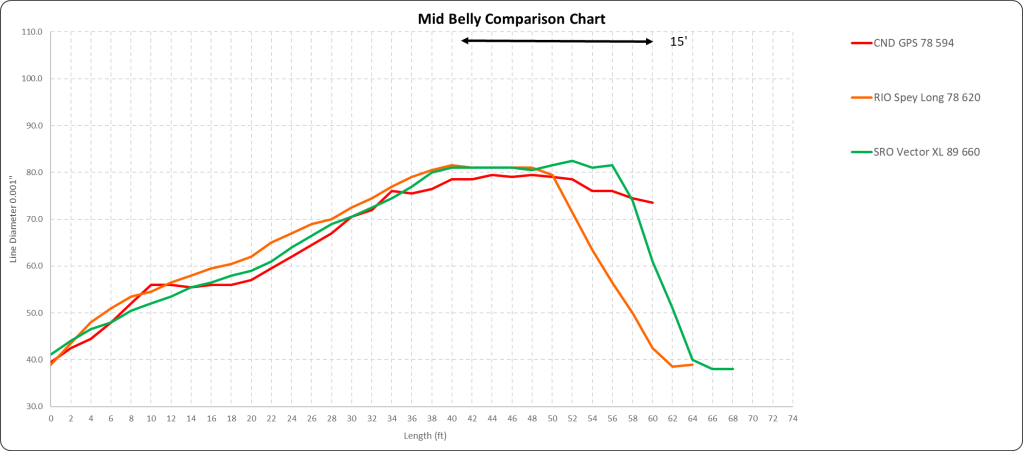
.
As the CND GPS 78 was one of the first lines I reviewed and measured on this journey, I did not measure to the running line, but right now, I find all three fine, but I prefer the RIO that provides a line:rod ratio of 3.5 for the Quantum and 3.8 for Meiser.
.
If I was going to continue to try other lines, I would consider as an alternative to RIO 78wt at 620 grains:
- Gaelforce Equalizer 63 78 Line which is a 662 grains (heavier, but very similar) (graph below, I am showing the 89).
- NextCast Fall Favourite 70 78 at 60′ and 660 grains head. (very different, with more weight at the rod tip)
- SRO Vector XL 78 (580 grains) for the Quantum, as it might like a lighter stiffer line.
- Where-as the SRO Vector 89 at 660 grains is slightly longer, but may still work? hmmm.
I noted a peer on Speypages has like the Fall Favourite on Quantum, and noted it has more power, but can fell heavy.
- Where-as the SRO Vector 89 at 660 grains is slightly longer, but may still work? hmmm.
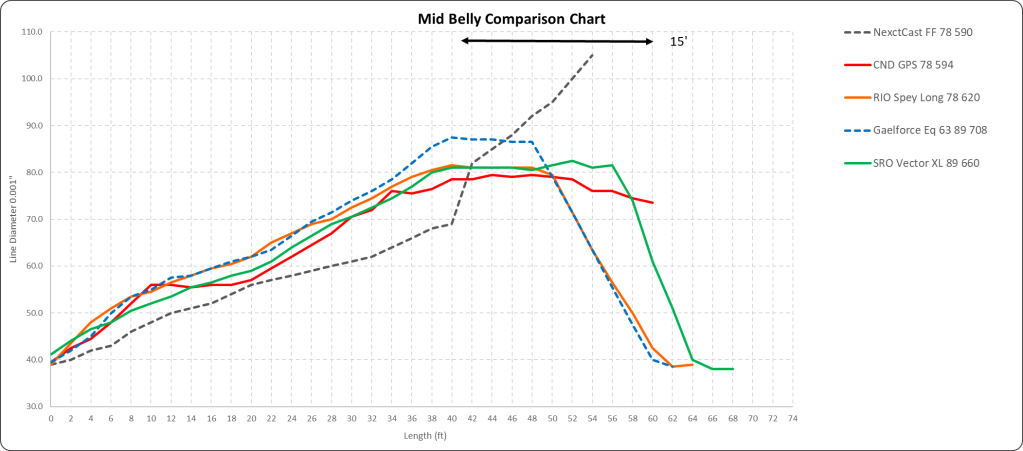
.
Maybe in 2024, I will be trialing out the SRO Vector XL 78 on the Quantum, as well as the FF 78.
.
Moving to
Bruce and Walker, Walker 16’6″ 8wt
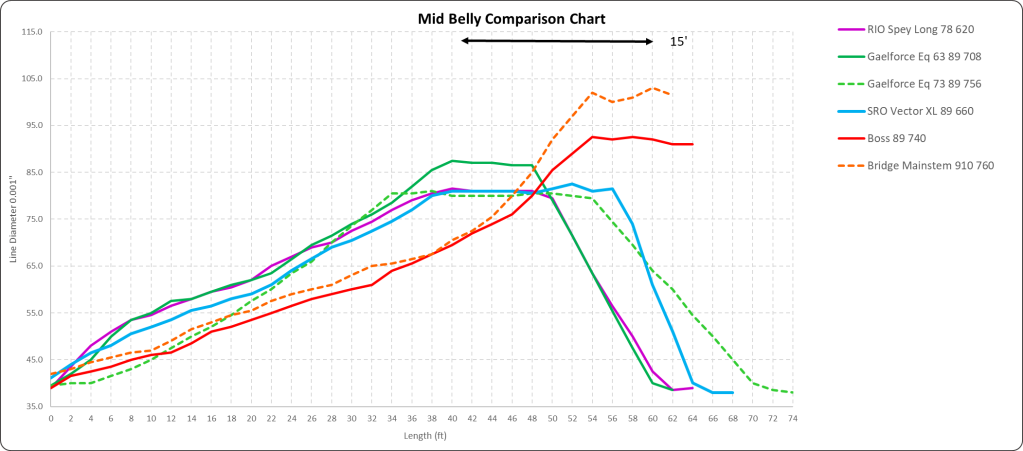
.
This was a late addition in 2023 into my quiver and did like the Boss 89 (from Gene who also represents Bruce and Walker), as well Gaelforce Equalizer 63 89. The Boss 89 64′ head at 740 grains maintains a 3.9 line to rod ratio on the Walker.
On alternatives:
- Bridge Mainstem 910 at 62+is very similar at 760 grains, but has more weight at the rod tip. I am not sure I want more weight at the tip for this rod.
- The lighter Bridge Mainstem is listed at 710 grains at 60′, could also be considered.
. - NextCast Fall Favourite 89 defined as 730 grains at 63′ (no data available, would likely be similar), with weight at a tip.
.
In the opposing direction, with a “flat” head, with weight distributed in the D-Loop, we would have, the
.
- The lighter Bridge Mainstem is listed at 710 grains at 60′, could also be considered.
- SRO Vector XL 910 – which would be 5′ longer and 750 grains than the illustrated 89 (lets suggest 61′ and 750 grains). I would expect it to be a stiffer line.
- Gaelforce Equalizer 73 910 if you want a flatter head than the SRO
Thought the above alternatives look viable, other than trying out the Bridge Mainstem 910, which I have, I believe I have stopped experimenting (and not spend another 300$ in lines) (for the Bridge Maintem 89 and the NextCast FF 89).
.
Loomis GLX 15′ 9wt and Walker 16’6″ 9wt
My story of the Loomis: The GLX is my second Spey Rod. I bought this rod, after I played with Rick Whorlwood’s GLX and really like it, but when I bought my rod, I was disappointed. There are several possibilities, but I was to new to Spey and too isolated to figure this out, this rod got shelved for many years (even tried to sell it).
My original line on this rods was the Airflo Deltas (bought via M&Y of Vancouver), which as shown below, has a long level head weight height.
As with my observations with the ACR 1173 and Airflo Rage, I (generally found that I) am not fond of this head style, but others may be.
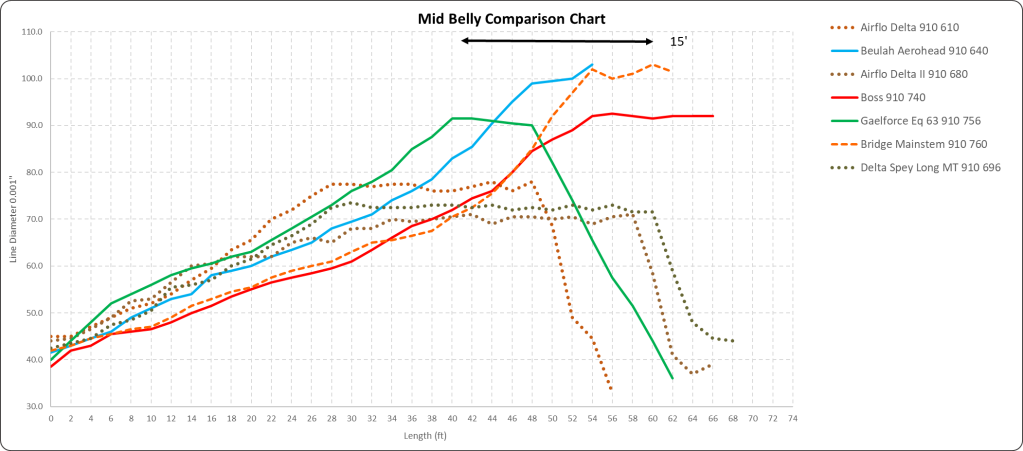
.
I picked up an Aerohead 910 for GLX and I liked.
Recently (in 2022), James at Gaelforce suggested the Equalizer 63 910, and I like it. I tried this line on the Walker 910 (in 2023) and I liked it.
So applying this knowledge to my on-the-water experience, what I have leave learnt I prefer a line with its weight concentrated at the tip.
.
Looking back to the CND GPS Unicorn, with their contemporaies
And then returning back to what made the CND GPS a the mythical beloved an eon ago, is that it to had a head with weight focus at the rod tip, and then a secondary belly, with RIO being the closest OEM today offering similar line.
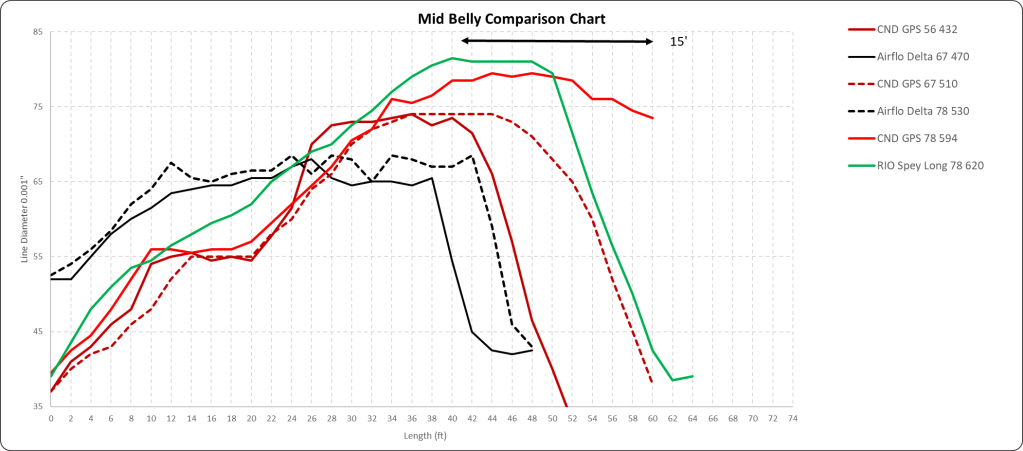
.
An observation: All 5 Airflo Delta lines in my collection (only showing 2 above) have the longest flat head, which does contravene their marketing message linked to Delta fly lines.
Though this graph does not include, I would note that one famous rod spey rod designer considering the SA Spey Classic of years ago one of the hardest to cast lines, and is used to validate his rods (id est, if it can cast the old SA Spey, it can cast anything). (I do have a SA Spey Classic, but I am not sure how faithful it is to the lines of the 90s).
.
So for my 9wts – Walker and-or GLX – restricted to the rare outing for Atlantic Salmon, with this knowledge, what lines would make sense?
- Gaelforce Equalizer 63′ 910 (756 grains) – got it, like it
- Boss 66′ 910 (740 grains) – got it, like it
- Bridge Mainstem 62′ 910 (760 grains) – got it, have not tested it (of it too heavy, then the 89)
. - NextCast Fall Favourite 70 89 at 730 grains at 63′
- NextCast Fall Favourite 70 910 at 800 grains and 65.8′, but be prepared to cut back.
- I show the smaller and lighter Nextcast FF 55, as this what I had.
- SRO Vector XL 910 – which would be 5′ longer and 750 grains than the illustrated 89, and provide an integrated running line. (I am showing the lighter 89 as I have it)
- Gaelforce Equalizer 73 910.
But this is not a rod I will put out often, so I will stop experimenting and stay with what I have.
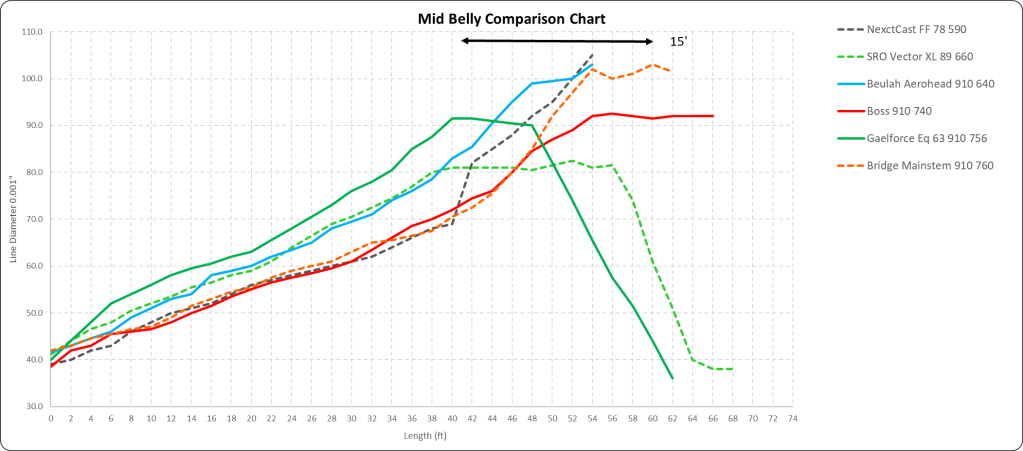
.
Illustrating the profile differences of Gaelforce Equalizer
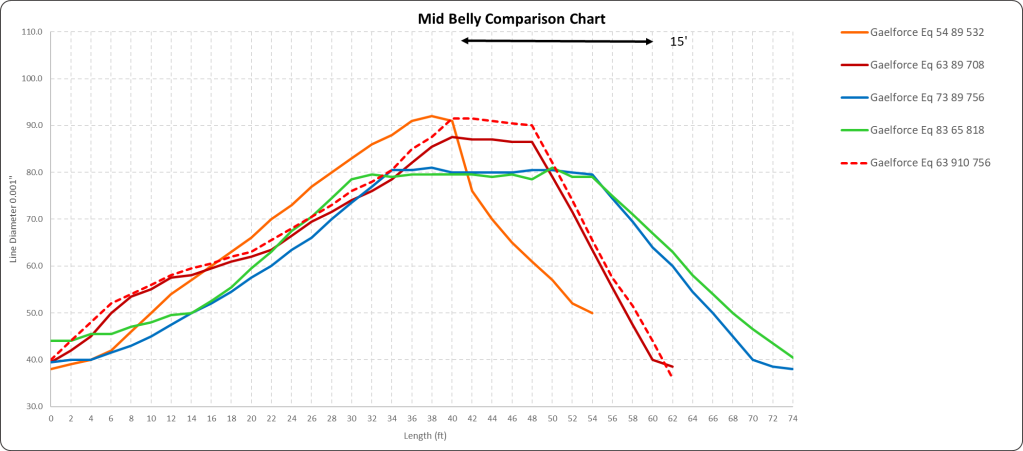
.
Probably no accident that James recommended the 63′ to help me with my woes with the GLX and it is the line he has modified to be an Intermediate.
I now think of the Gaelforce 53 as a long Scandi with a running line, and would suggest one look to the Gaelforce ESH or Bridge Tributary.
.
So closing my 2023 journey, applying some noted-recorded observations against some actual measurements., I have found there are many lines out there – and commercially available in 2023 – that I like:
- Boss
- Bridge – Tributary for Scandi, Winteride for Multi-Tip. Next year, I will test out the Mainstem.
- Gaelforce – Equalizer 63 and ESH
- Guideline’s 3D and 4D Scandi
- Nextcast
- RIO’s current crop of lines – Scandi, Long Spey
- Would like them to create a tapered “replacement” tip, like the old Airflo’s
- SRO Vector and Vector XL
We are fortunate we have enthusiasts such as Tim (Bridge), Simon (NextCast) and James (Gaelforce) who are dedicated to provide us really good lines.
.
::
.
Spey Multi-Tip Line Survey
Continuing series on Spey Line measurements, lets look at my Multi-Tip lines, which are in many ways long Scandi lines with a tip option or a Short Belly line with a weighted tip option.
Q: So if I have these lines and a dozen plus Scandi, which do I prefer?
A: Neither, but the Multi-Tip lines are more cost effective than a set of Scandi to cover a broad river depth. If I have preferences, it is more about the individual line design more than type, as exemplified two of my favourites is the Bridge WinterTide and the Guideline 3D series.
.
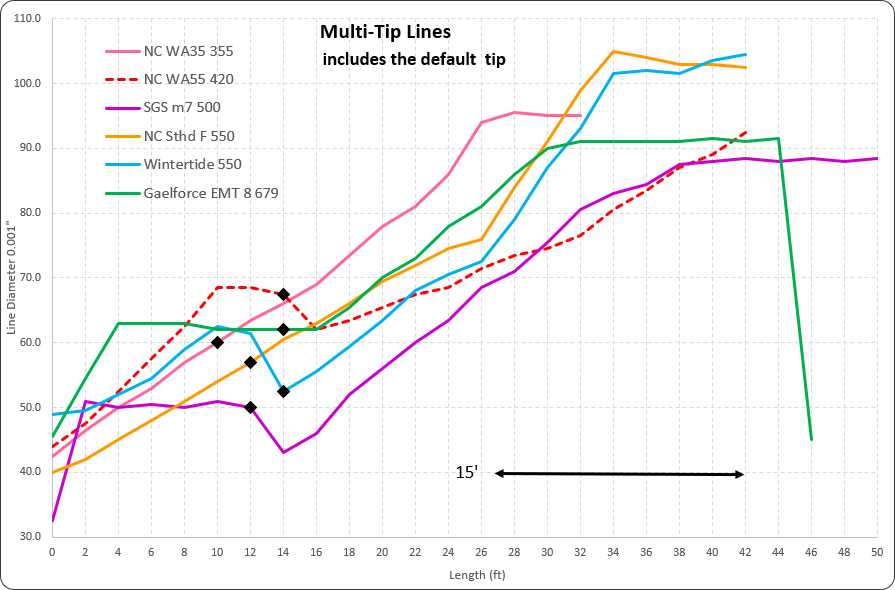
.
Some all important notes:
- Correction the Guideline Tip is from their 4D Series
. - The black diamond denotes the last measurement of the default tip.
- The weights listed are just of the head, without the tip. Some lines are marketed with the combine length and weight, sometimes not.
- Sometime the default tip was the best choice, and sometimes not.
. - Looking at each line, from lightest to heaviest:
.- NextCast WA35 and bought with a NextCast 10′ 65 grain tip (discontinued) is really nice on the Meiser 1305S 5pc. My tip kit would be the RIO 10′ 6wt 65 grain.
. - NextCast WA55 and was provided with a nice NextCast tip, but it is heavy. It never made the cut to be used on a rod, and now that see what tip was used with it and the lack of the step weight at the rod tip, I understand why it never “sang to me”. Likely to be sold in my 2024 clean-up sale.
. - SGS M7 provided with a Meiser 13668-6 CX rod. This is better as a Scandi Line with Polyleaders. The tip is unique and nice, and it looks like a line created from another RIO line, which should be re-purposed into another kit – probably the RIO 7wt 15′ 95 grains to be used with the WinterTide 89 with the Bruce & Walker Walker 8wt 13’6″ 6pc.
. - NextCast Steelhead Finder – Nice line and I really like it with the Meiser 13668. The supplied tip from Nextcast also very nice, and accompany the Airflo 7wt 12′ (the alternative would be the RIO 7wt 15′ grains).
.
I suspect this line would also be great on the Walker 13’6″ 8wt.
. - Wintertide 89 – one of newest lines and really well suited for the Walker 8wt 13’6″. I am fond of the Guideline 3D Compact on it and I will either expand on Guideline for the heavier line and add in SGS m7 floating tip to the kit.
. - Gaelforce EEMT 89 is with loved by a few with the above Walker, but I enjoyed the Wintertide. (Next year sale?)
.
- NextCast WA35 and bought with a NextCast 10′ 65 grain tip (discontinued) is really nice on the Meiser 1305S 5pc. My tip kit would be the RIO 10′ 6wt 65 grain.
Looking at the NextCast lines
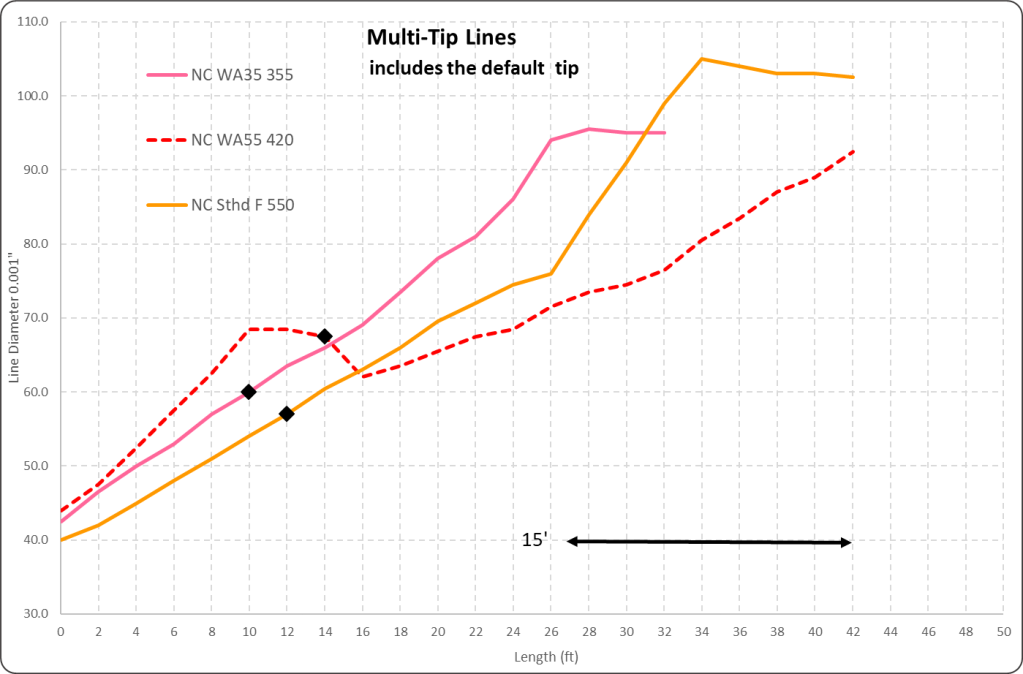
.
As above, both the WA35 and NextCast Steelhead Finder has found a home, but WA55 is not a line that I found love with. Whether it is a mis-match in tip or lack at focus weight at the top..
.
My heavy lines

.
The NextCast Steelhead Finder is great on my Meiser 13668-6 CX, I suspect it would be also be on the Walker 13’6″ 8wt, which likes the Bridge Line. With the Bridge, I am incline to use the finer Airflo 7wt 12′ 75 grains for the Bridge and the heaver RIO 7wt 15′ 9r grams for the NextCast Steelhead Finder.
When I am done with this analysis, maybe I should be consolidating my kit for both lines.
And though there is a lot of love out there for the Gaelfoce EEMT 89 for the Walker, it did not hit a soft spot for me. Clearly the head is larger, and the line heavier, with that typical RIO tip.
.
Focusing on the tips …..
Now, if you invest in these lines, you are likely need to pick up tips. And the dominant still in-production provider is RIO (their Replacement Tips). This is my current selection of RIO, and a discontinued Airflo), for reference:

.
In the above Table, green means I have the tips and yellow is no I do not these tips (yet?). I have taken the wets as provided by RIO and measured the diameter at the head for the floating and intermediate.
The sets that are getting attention are the
- RIO 6wt 10′ 65 grains with the Meiser 1305S & WA35 355 grains
- RIO 6wt 15′ 84 grains with Scott ARC 9699 and RIO SH VersiTip
- Airflo 7wt 12 75 grains with the Scott ARC 1007 & Airflo 7 MultiTip
- RIO 7wt 15′ 95 grains for the DH 7s and 8s
- RIO 9wt 15′ 129 grains (may add in 8wt floating tip) with the Walker 13’6′ 8wt & Gaelforce EEMT 89.
I will the first to acknowledge that the diameter is only one indicator to help understand how well a line will turn over a tip, and after my testing (besides just measuring), you can really skip over the many kits.
Measurements of similar tips from different line manufacturers.
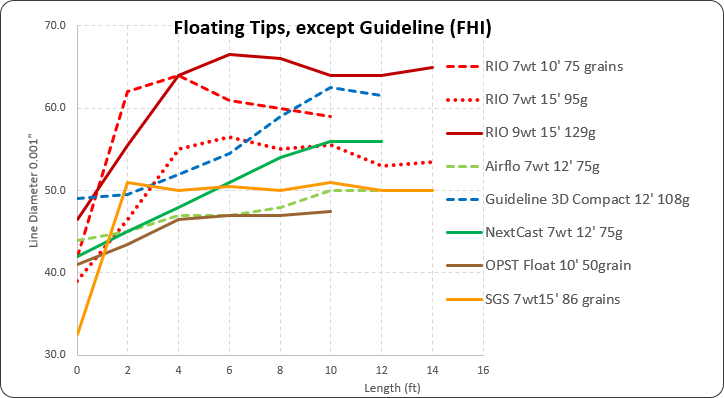
.
RIO’s tips are effectively a level and then a final taper, and while this works, probably could be better. The discontinued NextCast (been replaced) would be better and the discontinued Airflo (no replacements) are nice and fine.
I have no SA Sonar Tips, and though expensive, consideration should be given to add Guideline 3D Compact 3D tips. These tips also appear to be similar to the Loop Tips.
Correction: The Guideline Tips are from their 4D Compact Series
.
And since I am looking at tips, lets summarize what I have and know about Poly I have discontinued or unicorn tips from

.
Last many of the measurements
Measurements are taken every 2 feet.
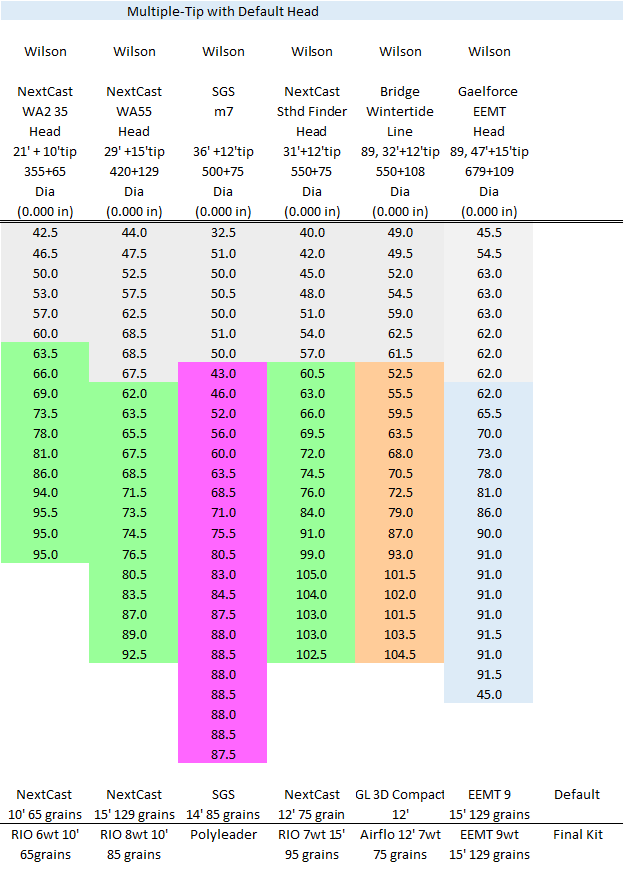
.
.
🙂
.
Scandi Line Survey
As previously posted, I do have an interest in understanding a line’s profile, as I can associate the profile with a preference to casting and presentation. Understanding the profile is a starting point, but not the end point.
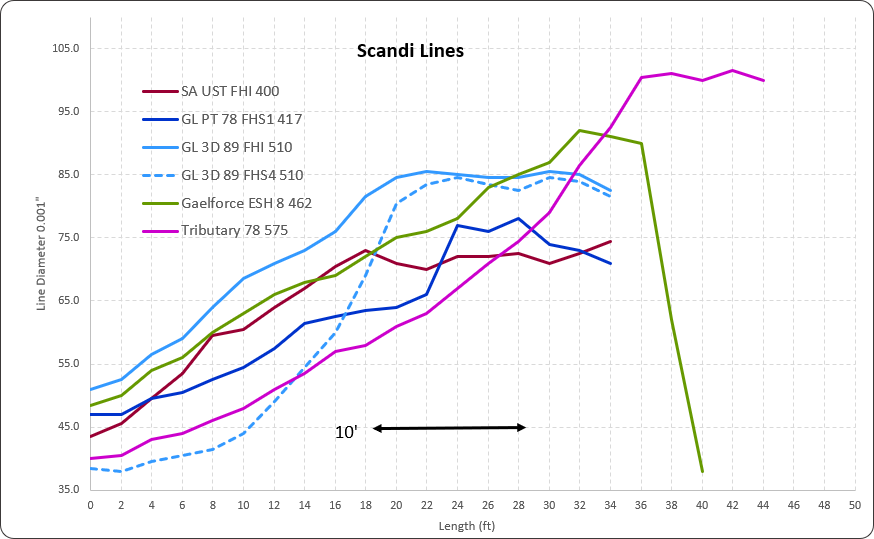
.
A few years, I became a “convert” for the Guideline 3D lines, especially the FHI for presenting flies in a run, and my recent playing with a Bridge Tributary Floating is fun; never-the-less I still like the Guideline’s for fishing. (I did not measure, a Guideline PT FHI at 478 grains).
For these lines, I am typically casting a rod ~13’6″, specifically:
- Burheimer 7134
- Meiser 13668-6 CX
- Bruce and Walker, Walker 13’6″ 6pc 8wt.
If we apply the axiom, a Scandi line should be 2.5x the rod length, these 34′ Guideline lines are just right and the Bridge line would better suited for a 15′ rod (and I have 15′ rods to).
The two lines that I like the least is Airflo Compact Scandi (previous post) and the SA UST on a Meiser 1305-S (13′ 5wt), both of which have the “dullest” head, and thus a lower authority at the tip of the rod. In fact, on this rod, I prefer a WA35 and change the tip.

.
Bob (Meiser) also recommended the WA35 420 for his1305 and it is similar to my other preferences, where the power is focus towards the tip.
The black diamond in the above graph denotes the tip transition – using a RIO 6wt replacement head.
- Oh yes, the NextCast WA 35 420 assumes the tip, as the line is 21′ and 355 grains. If I put on a 10′ 6wt tip, then the final line is ~ 31′ 420 grains.
In conclusion, I really like a Scandi line that has power (authority) at the tip.
.
🙂
.
Post Publication Add: I forgot the everything graph

and then the lines I really like out of these
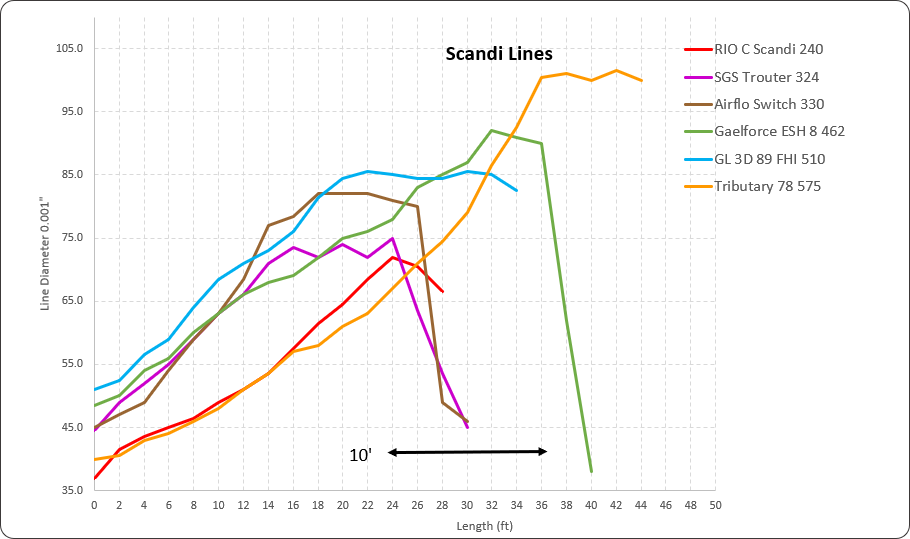
.
- RIO Scandi 240 on the ACR 1173
- SGS Trouter 324 on a Meiser 1264S
- Airflo Switch on 330 on a James Green 1005
- Gaelforce ESH 8 on a Burkheimer 7134
- Guildeline 3D FHI (478 (and 510) on a Burkheimer 7134
- Tributary 78 on a Meiser 1507S
.
.
Scandi Lines for the ACR 1173 Spey Rod
I have put lot of emphasis in the past on the taper – which is important for single hand, as some lines place power/distance over presentation – but what is harder to study is the impact of the core and selection of the plastic modifiers. Hence-forth, I will continue to examine the taper to narrow my choice, as I acknowledge it is the complete line construction that is important.
This holds true also for Spey Lines, but looking at a taper will assist in determine what might be best (and I am starting to be able to articulate what I prefer).
Earlier, in the summer of 2021, I noted with the Gary Anderson ACR1173 I definitely preferred the RIO Compact Scandi 240 grain (supplied with the rod) versus Airflo, though it has the same weight and length.
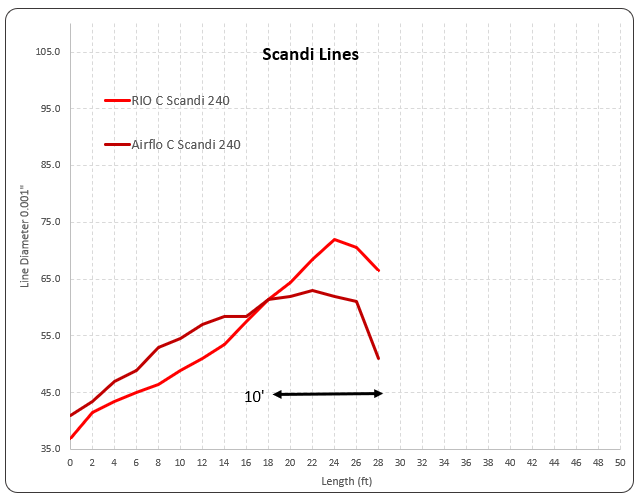
.
As we examine how the line weight is distributed, the RIO places more authority at the tip of the rod, which would enable generating more power to roll-out the line. I can compensate for Airflo wide head by acquiring a heavier Airflo, which would allow for heavier flies, but I would be losing that nice light small fly cast.
For me, the ACR1173 with the RIO provides for a nice light touch-n-go, to quickly re-present the fly in a run, and I can attribute this to the authority in the tip.
Q: Which is better – a heavier Airflo or the RIO in hand?
A: Arguably neither, but what I prefer is using the ACR 1173 for light small fly drifts, and thus lets keep using the RIO Compact Scandi.
.
🙂
.
Meiser 1507S Spey Rod
I found and bought an old Meiser 1507S blank, and though this series of blanks has been discontinued, I have and still like (very much) how they cast and fish. My first Meiser S, a 1264S for trout, remains a goto.

.
I found this rod to be flexible and forgiving, so my choices of reels and lines include:
- for dry-line and top-water with mono-filament leaders: Henshaw Platewind Reel at 13 ounces with a Bridge Tributary 78 44′ at 575 grains
- for winter and using tips: Nautilus 12S with the NextCast Stealhead Finder 89 30′ at 550 grains + RIO Replacement tips.
.
and
. - for fine and long, the Nautilus 12S with RIO Spey Long 78 64′ at 620 grains
Depending on the river and mood, I will pick the line I want.
This is my second long rod that I have built, and the differences from the previous build, a Quantum 16’7″ 7wt:
- Butt: I do like a “large” round half ball butt, but the transition is less extreme. One reason for this was practical, as the black rubberized cork was not behaving well as I shaped it – irrespective of what technique or tool I was using. I have since marked the few black discs that I have left as “use only if need is an absolute”.
.
If this finishing issue did not exist, I would have a sharper radius going into the butt, maybe a little less aggressive than the Quantum though.
. - Reel Seat: From Snake Brand, but I turned my own insert from a double dyed resign wood block that I bought from the Ukraine (via Etsy) and finished with Super Cyanoacrylate.
. - I have also added a little more colour with the thread wraps, but not shown.
- Dark saturated blue on the Guides
- At the ferrules, Graphite Grey with blue trim (dark and light blue)
.
In future, I will to return to adding colour trim on the guides.
.
- Guides are Snake Brand (older Black Series) and Fuji Guides for the Stripper.
And what did I continue with:
- The other handle transition in-out of the reels seat is continuous, to allow the hand to easily slide against the reel.
. - The swell at the top of the rod is small. Allowing my hand to slide over, but also provide some feedback I am at the top end.
. - Small-short rear handle, to help with using lighter reels to achieve a balance point on the top cork.
. - Ends have rubberized cork for improve wear.
. - Use quality natural cork in the top 2/3 of the upper handle, with the remainder being a burl cork.
- And though both corks are finely finished, with wet hands I notice a difference, and prefer the natural cork,
.
- And though both corks are finely finished, with wet hands I notice a difference, and prefer the natural cork,
- Thread:
- Main Colour on Guides, and Trim Colour on Ferrules: ProWrap ColourFast 455 Blue Size A
- Main Colour on Ferrules: Prowrap Graphite Grey 841Size A
- Trim Colour: ProWrap Colour Fast 404 Size A.
.
Will I build another spey rod?
Well I have several really nice 7wt and 8wts – enabling winter-fishing, travel and long line – from Meiser, Burkheimer and Bruce-and-Walker, so the right answer is no.
I want to finish up a variant update on a James Green 10′ 5wt, but I think my time should start looking to another task, is est return to bamboo trout rods.
.
| | B 7134 | M136-6CX | M1507S | Q167 | BW136-6 | BW166 |
| OEM | Burkheimer | Meiser | Meiser | Godshall | B & Walker | B & Walker |
| Model | 7134-4 | 13668CX-6 | 1507S-4 | Quantum | Walker 8wt | Walker 8wt |
| Role | Winter | Travel | Universal | Far & Fine | Salmon | Salmon |
| Grain Min | 420 | 450 | 450 | | | |
| Grain Max | 570 | 750 | 750 | | | |
| Reel | Nautilus 12S . . | Nautilus 12S Henshaw . | Henshaw Nautilus 12S Nautilus 12S | Nautilus 12S . , | Stewart 300 . . | Saracione . . |
| Default Line | Ga ESH 8 | NC STF 89 | Tributary 78 | RIO Long 78 | Wintertide | Boss 89 |
| Weight | 37′ 462g | 29′ 550g | 44′ 575g | 65′ 660g | 32′ 550g | 65′ 740g |
| Tippet | Polyleader | 7 15′ 95g | Mono | Mono | 7 15′ 95g | Mono |
.
🙂


